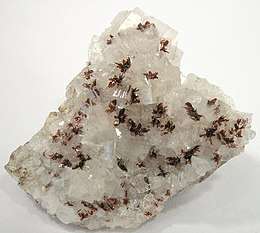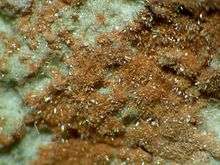Ruizite
Ruizite is a sorosilicate mineral with formula Ca2Mn2Si4O11(OH)4·2H2O. It was discovered at the Christmas mine in Christmas, Arizona, and described in 1977. The mineral is named for discoverer Joe Ana Ruiz.
| Ruizite | |
|---|---|
 Clusters of ruizite on calcite from South Africa | |
| General | |
| Category | Sorosilicate |
| Formula (repeating unit) | Ca2Mn2Si4O11(OH)4·2H2O[1] |
| Strunz classification | 9.BJ.35 |
| Dana classification | 57.2.2.1 |
| Crystal system | Monoclinic |
| Crystal class | Prismatic (2/m) (same H-M symbol) |
| Space group | P21/c |
| Unit cell | a = 11.95 Å, b = 6.17 Å c = 9.03 Å, β = 91.37°; Z = 4 |
| Identification | |
| Color | Orange, red-brown |
| Twinning | Common on {100} |
| Mohs scale hardness | 5 |
| Streak | Apricot |
| Diaphaneity | Translucent |
| Optical properties | Biaxial (-) |
| Refractive index | nα = 1.663 nβ = 1.715 nγ = 1.734 |
| Birefringence | δ = 0.071 |
| 2V angle | 60° |
| References | [2] |
Description and occurrence

Ruizite is translucent and orange to red-brown in color with an apricot yellow streak.[2] The mineral occurs as euhedral prisms up to 1 mm (0.039 in) or as radial clusters of acicular (needle-like) crystals.[1]
Ruizite is common at the Christmas mine.[3] The mineral is known from Arizona, Pennsylvania, and Northern Cape Province, South Africa.[2] Ruizite occurs in association with apophyllite, bornite, calcite, chalcopyrite, datolite, diopside, grossular, inesite, junitoite, kinoite, orientite, pectolite, quartz, smectite, sphalerite, vesuvianite, and wollastonite.[1] Ruizite is found in veinlets or fracture surfaces of limestone metamorphosed into a calc-silicate assemblage. The mineral formed by retrograde metamorphism during cooling of a calc–silicate skarn assemblage in an oxidizing environment.[1][3]
Crystal structure and chemistry
Ruizite crystallizes in the monoclinic crystal system and twinning is common along the {100} plane between exactly two crystals.[1] Ruizite's formula was originally identified as CaMn(SiO3)2(OH)2·2H2O in 1977.[3] In 1984, Frank C. Hawthorne revised the formula to Ca2Mn2Si4O11(OH)4·2H2O.[4] Ruizite's structure consists of edge-sharing Mnφ6 octahedra, connected at corners into sheets and together into a lattice by clusters of Si4O11(OH)2.[5]
Nitric acid, hydrochloric acid, and potassium hydroxide have little effect on ruizite at low temperatures but readily dissolve the mineral at elevated temperatures.[6]
History
During the investigation of junitoite at the Christmas mine in Christmas, Arizona, Joe Ana Ruiz and Robert Jenkins discovered an unknown brown mineral. Mine geologist Dave Cook located better specimens, and it was determined to be a new mineral species. The mineral was named ruizite in honor of Joe Ruiz as discoverer. Ruizite's properties were analyzed using a sample provided by Joseph Urban, and it was described in the journal Mineralogical Magazine in December 1977.[7] The International Mineralogical Association approved the mineral as IMA 1977-077.[8] Type specimens are housed in the University of Arizona, Harvard University, the National Museum of Natural History, and The Natural History Museum.[1]
See also
References
- Anthony, John W.; Bideaux, Richard A.; Bladh, Kenneth W.; Nichols, Monte C. (eds.). "Ruizite" (PDF). Handbook of Mineralogy. Chantilly, VA: Mineralogical Society of America.
- "Ruizite". Mindat. Retrieved December 2, 2012.
- Williams & Duggan 1977, p. 429.
- Dunn, Pete J. (March–April 1985). "New Mineral Names, New Data" (PDF). American Mineralogist. 70 (3–4): 441.
- Hawthorne 1984, p. 135.
- Williams & Duggan 1977, p. 431.
- Williams & Duggan 1977, p. 432.
- "The New IMA List of Minerals – A Work in Progress – Update: November 2012" (PDF). Commission on New Minerals, Nomenclature and Classification. International Mineralogical Association. p. 146. Retrieved December 2, 2012.
- Bibliography
- Hawthorne, F. C. (1984). "The crystal structure of ruizite, a sorosilicate with an [Si4Ø13] cluster". Tschermaks mineralogische und petrographische Mitteilungen. 33 (2): 135–146. doi:10.1007/BF01083069.CS1 maint: ref=harv (link)
- Williams, Sidney A.; Duggan, M. (December 1977). "Ruizite, A New Silicate Mineral from Christmas, Arizona" (PDF). Mineralogical Magazine. 41 (320): 429–432. doi:10.1180/minmag.1977.041.320.01.CS1 maint: ref=harv (link)
Further reading
- Moore, Paul B.; Shen, Jinchuan; Araki, Takaharu (January–February 1985). "Crystal chemistry of the 2∞[M3+2φ2(TO4)2]sheet: structural principles and crystal structures of ruizite, macfallite and orientite" (PDF). American Mineralogist. 70 (1–2): 171–181.
External links
![]()